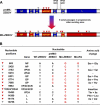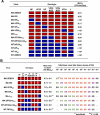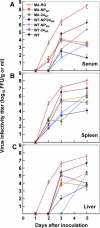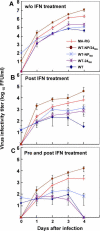Molecular determinants of Ebola virus virulence in mice
- PMID: 16848640
- PMCID: PMC1513261
- DOI: 10.1371/journal.ppat.0020073
Molecular determinants of Ebola virus virulence in mice
Abstract
Zaire ebolavirus (ZEBOV) causes severe hemorrhagic fever in humans and nonhuman primates, with fatality rates in humans of up to 90%. The molecular basis for the extreme virulence of ZEBOV remains elusive. While adult mice resist ZEBOV infection, the Mayinga strain of the virus has been adapted to cause lethal infection in these animals. To understand the pathogenesis underlying the extreme virulence of Ebola virus (EBOV), here we identified the mutations responsible for the acquisition of the high virulence of the adapted Mayinga strain in mice, by using reverse genetics. We found that mutations in viral protein 24 and in the nucleoprotein were primarily responsible for the acquisition of high virulence. Moreover, the role of these proteins in virulence correlated with their ability to evade type I interferon-stimulated antiviral responses. These findings suggest a critical role for overcoming the interferon-induced antiviral state in the pathogenicity of EBOV and offer new insights into the pathogenesis of EBOV infection.
Conflict of interest statement
Figures




Similar articles
-
The Ebola virus glycoprotein contributes to but is not sufficient for virulence in vivo.PLoS Pathog. 2012;8(8):e1002847. doi: 10.1371/journal.ppat.1002847. Epub 2012 Aug 2. PLoS Pathog. 2012. PMID: 22876185 Free PMC article.
-
Genetic factors of Ebola virus virulence in guinea pigs.Virus Res. 2010 Oct;153(1):121-33. doi: 10.1016/j.virusres.2010.07.015. Epub 2010 Jul 21. Virus Res. 2010. PMID: 20654661
-
VP24 is a molecular determinant of Ebola virus virulence in guinea pigs.J Infect Dis. 2011 Nov;204 Suppl 3:S1011-20. doi: 10.1093/infdis/jir338. J Infect Dis. 2011. PMID: 21987737
-
Current knowledge on lower virulence of Reston Ebola virus (in French: Connaissances actuelles sur la moindre virulence du virus Ebola Reston).Comp Immunol Microbiol Infect Dis. 2007 Sep;30(5-6):391-8. doi: 10.1016/j.cimid.2007.05.005. Epub 2007 Jul 3. Comp Immunol Microbiol Infect Dis. 2007. PMID: 17610952 Review.
-
The pathogenesis of Ebola hemorrhagic fever.Trends Microbiol. 2001 Oct;9(10):506-11. doi: 10.1016/s0966-842x(01)02201-6. Trends Microbiol. 2001. PMID: 11597453 Review.
Cited by
-
Ebolavirus Database: Gene and Protein Information Resource for Ebolaviruses.Adv Bioinformatics. 2016;2016:1673284. doi: 10.1155/2016/1673284. Epub 2016 Apr 14. Adv Bioinformatics. 2016. PMID: 27190508 Free PMC article.
-
Generation and Characterization of a Mouse-Adapted Makona Variant of Ebola Virus.Viruses. 2019 Oct 26;11(11):987. doi: 10.3390/v11110987. Viruses. 2019. PMID: 31717793 Free PMC article.
-
An overview of viral mutagenesis and the impact on pathogenesis of SARS-CoV-2 variants.Front Immunol. 2022 Nov 28;13:1034444. doi: 10.3389/fimmu.2022.1034444. eCollection 2022. Front Immunol. 2022. PMID: 36518757 Free PMC article. Review.
-
Adaptation of Borna disease virus to new host species attributed to altered regulation of viral polymerase activity.J Virol. 2007 Aug;81(15):7933-40. doi: 10.1128/JVI.00334-07. Epub 2007 May 23. J Virol. 2007. PMID: 17522214 Free PMC article.
-
Filovirus Virulence in Interferon α/β and γ Double Knockout Mice, and Treatment with Favipiravir.Viruses. 2019 Feb 3;11(2):137. doi: 10.3390/v11020137. Viruses. 2019. PMID: 30717492 Free PMC article.
References
-
- Sanchez A, Khan AS, Zaki SR, Nable GJ, Ksizack TG, et al. Filoviridae: Marburg virus and Ebola virus. In: Knipe DM, Howley PM, Griffin DE, Lamb RA, Malcolm AM, et al., editors. Field's virology. 4th edition. Philadelphia: Lippincott Williams & Wilikins. pp. 1279–1304 2001.
-
- Geisbert TW, Jahrling PB. Exotic emerging viral diseases: Progress and challenges. Nat Med. 2004;12(Suppl):S110–S121. - PubMed
-
- Feldmann H, Jones S, Klenk HD, Schnittler HJ. Ebola virus: From discovery to vaccine. Nat Rev Immnol. 2003;3:677–685. - PubMed
-
- Feldmann H, Volchkov VE, Volchkova VA, Klenk HD. The glycoproteins of Marburg and Ebola virus and their potential roles in pathogenesis. Arch Virol Suppl 15: 159–169. 1999. - PubMed
-
- Feldmann H, Volchkov VE, Volchkova VA, Stroher U, Klenk HD. Biosynthesis and role of filoviral glycoproteins. J Gen Virol. 2001;82:2839–2848. - PubMed
Publication types
MeSH terms
Substances
Grants and funding
LinkOut - more resources
Full Text Sources
Other Literature Sources
Medical

